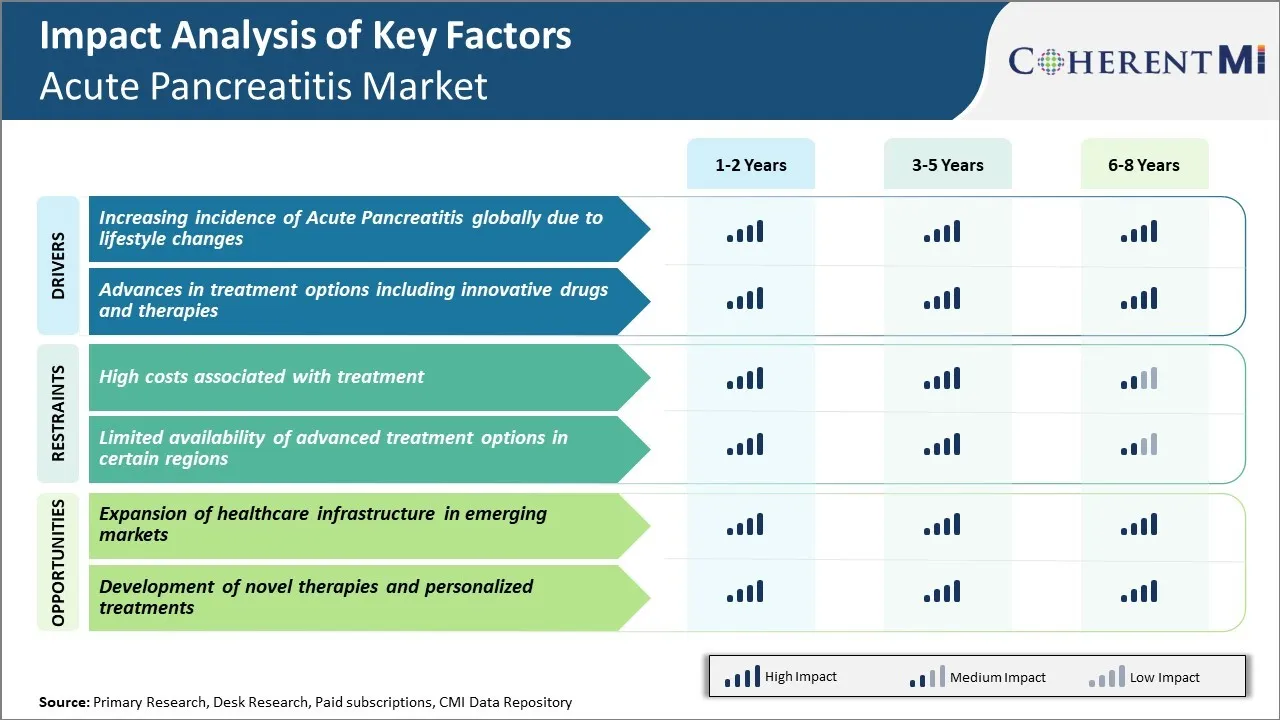急性膵炎 マーケット 規模およびシェア分析 - 成長トレンドおよび予測 (2024 - 2031)
急性膵炎 市場は治療(薬物療法、支持療法、手術)、エンドユーザー(病院、診療所、Ambulatory Surgical Center)、原因によって(Gallstones、慢性アルコール使用、その他)、流通チャネル(病院薬局、小売薬局)、地理学(北アメリカ、ラテンアメリカ、アジアパシフィック、ヨーロ....
急性膵炎 マーケット トレンド
市場ドライバ - ライフスタイルは、急性膵炎で上昇を燃やす変化 ケース
急性膵炎の世界的な発生率は、過去数十年にわたって着実に上昇しています。 この上昇の背後にある重要な要因は、より多くの人々が採用している広範なライフスタイルの変化でした。 不健康な食習慣、身体の不活性、過剰なアルコール消費および喫煙は、急性膵炎を発症するための重要なリスク要因と考えられている主要なライフスタイルの側面の一部です。
過剰なアルコール摂取量は、特に若い人口統計グループの間で、同様に非常に一般的になりました。 ビンジドリンクは、ほとんど多くの人にカジュアルなソーシャル化として見られます。 しかし、医学研究は、重いスラブや定期的なアルコール消費が簡単に急性膵炎の攻撃を引き起こす可能性があることを明らかに示しています。 同様に、世界中のスモーカーの数は、抗タバコキャンペーンにもかかわらず、警戒的に高まっています。 タバコの喫煙は、急性膵炎の多くの症例で暗示されている十分に確立されたリスク要因です。
上記のライフスタイル習慣はすべて、体重増加、代謝障害を促進し、消化器官に追加の緊張をかけると、急性膵炎の発生に急激につながります。 不協調な努力は、不適切な現代的なライフスタイルからステムな急性膵炎の質量スケールでより健康的なライフスタイルの変化を促進するために作られています。
市場ドライバー - 急性膵炎の治療オプションの進歩
実質的な進歩が発生した重要な領域の1つは、根本的な原因を治療し、病気プロセスを調節するための薬物開発にあります。 過去10年間にいくつかの臨床試験は、膵炎症を軽減し、回復を加速することができる異なる薬を評価しました。 調査の下の少数の有望な薬剤のクラスは酵素の抑制剤、酸化防止剤、炎症抑制剤および特定の免疫調節剤を含んでいます。 実証済みの安全かつ効果的な場合、これらの新しい薬処方は、急性膵炎症症例に対処するために臨床医の脇下を強化します。
同時に、最小限に侵襲的な外科的技術と介在的内視鏡的オプションも地面を獲得しています。 内視鏡レトログレードのcholangiopancreatography(ERCP)のような手順は、頻繁に膵炎の攻撃を緩和する胆石のような条件を診断し、対処することができます。 同様に、問題のある膵管に排水のステントを置く手順は、合併症の管理を後押ししています。 高度なイメージング方法と画像ガイド精度の統合により、このようなインターベンションアプローチをさらに拡張しました。
全体的に、治療パラダイムの継続的な改善は、革新的な薬と技術のストリームによって支持され、急性膵炎の患者の結果と生活の質を向上させるために井戸を引き起こします。 この進歩は、この業界の商業的な見通しを強化することを期待しています。これは、従来のケアの基準に、より適格でより効果的な治療薬の需要が高まります。

市場課題 - 治療に伴う高コスト
急性膵炎市場で直面する主要な課題の1つは、治療に関連する高いコストです。 急性膵炎は、入院および集中的な医療を必要とします。 治療は、静脈内流体および痛み薬の管理と共に広範な監視を含みます。 重症例では、外科的介入がさらに全体的なコストを増加させる必要がある場合があります。
病気の複雑な性質上、患者様あたりの治療費はかなり高い。 推定値として、患者ごとの平均総コストは、重症度レベルに応じて、米国では$ 15,000から$ 30,000です。 患者さんとその家族に大きな負担をかけます。 また、院内は急性膵炎に関連した病院にとどまり、地域全体に既に過給された医療システムに付加的な費用の圧力を置くことはかなり長くなっています。
急性膵炎の上昇の発生率によって、処置の支出は著しく成長するために写っています。 しかしながら、ヘルスケア予算や払い戻しの制限は、増加する病気の負担に対処するための制約をポーズします。 これは、アクセス可能で手頃な価格のケアを確保するために取り組む必要がある主要な市場課題として機能します。
市場機会 - 新興市場でのヘルスケアインフラの拡大
急性膵炎市場の主要な機会の1つは、新興市場での医療インフラの拡大です。 ヘルスケア施設の構築や先進国における治療オプションへのアクセスの改善に向けた投資が高まっています。
これにより、新しい病院の設置、農村部の医療インフラの拡大、さまざまな政府の人による医療費の増大などが挙げられます。 これらの開発の結果として、より多くの患者は、遠隔地でも急性膵炎のタイムリーな治療を求めることができます。
また、診断機能の向上により、早期発見と病態管理が可能となります。 この要因は、新興国の市場成長に積極的に影響を与えています。 ヘルスケアシステムを強化するためのさらなる計画投資により、新興市場は、今後数年間にわたり、急性膵炎市場での選手にとって重要な拡大見通しを提供することが期待されます。 企業はこれらの高い潜在的な地域に焦点を合わせ、高められた医学の必要性に食料調達することによって競争の端を得ることができます。